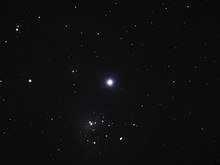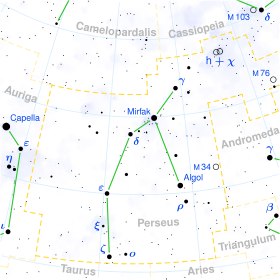Omicron Persei
Omicron Persei (ο Persei, abbreviated Omicron Per, ο Per) is a triple star system in the constellation of Perseus. From parallax measurements taken during the Hipparcos mission it is approximately 1,100 light-years (340 parsecs) from the Sun.
| Observation data Epoch J2000 Equinox J2000 | |
|---|---|
| Constellation | Perseus |
| Right ascension | 03h 44m 19.13204s[1] |
| Declination | 32° 17′ 17.6929″[1] |
| Apparent magnitude (V) | 3.83[2] |
| Characteristics | |
| Spectral type | B1III / B2V[3] |
| U−B color index | -0.75[2] |
| B−V color index | +0.05[2] |
| Variable type | ellipsoidal[4] |
| Astrometry | |
| Radial velocity (Rv) | +12.20[5] km/s |
| Proper motion (μ) | RA: +8.18[1] mas/yr Dec.: -10.43[1] mas/yr |
| Parallax (π) | 2.91 ± 0.73[1] mas |
| Distance | approx. 1,100 ly (approx. 340 pc) |
| Details | |
| Mass | 15.5[6] M☉ |
| Luminosity | 61,869[7] L☉ |
| Temperature | 22,840[8] K |
| Rotational velocity (v sin i) | 90[9] km/s |
| Other designations | |
| Database references | |
| SIMBAD | data |
The system consists of[10] a binary pair designated Omicron Persei A and a third companion Omicron Persei B. A's two components are themselves designated Omicron Persei Aa (officially named Atik /ˈeɪtɪk/, the traditional name of the system)[11][12] and Ab.
Nomenclature

ο Persei (Latinised to Omicron Persei) is the system's Bayer designation. The designations of the two constituents as Omicron Persei A and B, and those of A's components - Omicron Persei Aa and Ab - derive from the convention used by the Washington Multiplicity Catalog (WMC) for multiple star systems, and adopted by the International Astronomical Union (IAU).[13]
It bore the traditional name Atik (also Ati, Al Atik), Arabic for "the shoulder". Some sources, including a planetarium software package, an atlas,[14] and a web site[15] attribute the name Atik to the nearby, brighter star Zeta Persei. In 2016, the International Astronomical Union organized a Working Group on Star Names (WGSN)[16] to catalogue and standardize proper names for stars. The WGSN decided to attribute proper names to individual stars rather than entire multiple systems.[17] It approved the name Atik for the component Omicron Persei A on 12 September 2016 and it is now so included in the List of IAU-approved Star Names.[12]
In Chinese, 卷舌 (Juǎn Shé), meaning Rolled Tongue, refers to an asterism consisting of Omicron Persei, Nu Persei, Epsilon Persei, Xi Persei, Zeta Persei and 40 Persei.[18] Consequently, the Chinese name for Omicron Persei itself is 卷舌五 (Juǎn Shé wu), "the Fifth Star of Rolled Tongue".[19]
Namesake
USS Atik was a ship of the United States Navy.
Properties
Omicron Persei A is a spectroscopic binary consisting of a spectral type B1 giant and a type B2 dwarf orbiting each other every 4.4 days.[3] Omicron Persei lies just north of the open cluster IC 348, but is not catalogued as a member. Both IC 348 and Omicron Persei belong to the Perseus OB2 association.[20]
References
- Van Leeuwen, F. (2007). "Validation of the new Hipparcos reduction". Astronomy and Astrophysics. 474 (2): 653–664. arXiv:0708.1752. Bibcode:2007A&A...474..653V. doi:10.1051/0004-6361:20078357. Vizier catalog entry
- Ducati, J. R. (2002). "VizieR Online Data Catalog: Catalogue of Stellar Photometry in Johnson's 11-color system". CDS/ADC Collection of Electronic Catalogues. 2237. Bibcode:2002yCat.2237....0D.
- Stickland, D. J.; Lloyd, C. (1998). "Spectroscopic binary orbits from ultraviolet radial velocities. Paper 28: Omicron Persei". The Observatory. 118: 138. Bibcode:1998Obs...118..138S.
- Samus, N. N.; Durlevich, O. V.; et al. (2009). "VizieR Online Data Catalog: General Catalogue of Variable Stars (Samus+ 2007-2013)". VizieR On-line Data Catalog: B/GCVS. Originally Published in: 2009yCat....102025S. 1. Bibcode:2009yCat....1.2025S.
- Pourbaix, D.; Tokovinin, A. A.; Batten, A. H.; Fekel, F. C.; Hartkopf, W. I.; Levato, H.; Morrell, N. I.; Torres, G.; Udry, S. (2004). "SB9: The ninth catalogue of spectroscopic binary orbits". Astronomy and Astrophysics. 424 (2): 727–732. arXiv:astro-ph/0406573. Bibcode:2004A&A...424..727P. doi:10.1051/0004-6361:20041213.
- Tetzlaff, N.; Neuhäuser, R.; Hohle, M. M. (2011). "A catalogue of young runaway Hipparcos stars within 3 kpc from the Sun". Monthly Notices of the Royal Astronomical Society. 410 (1): 190–200. arXiv:1007.4883. Bibcode:2011MNRAS.410..190T. doi:10.1111/j.1365-2966.2010.17434.x. Vizier catalog entry
- Hohle, M.M.; Neuhäuser, R.; Schutz, B.F. (2010). "Masses and luminosities of O- and B-type stars and red supergiants". Astronomische Nachrichten. 331 (4): 349. arXiv:1003.2335. Bibcode:2010AN....331..349H. doi:10.1002/asna.200911355. Vizier catalog entry
- Zorec, J.; Cidale, L.; Arias, M. L.; Frémat, Y.; Muratore, M. F.; Torres, A. F.; Martayan, C. (2009). "Fundamental parameters of B supergiants from the BCD system". Astronomy and Astrophysics. 501: 297–320. arXiv:0903.5134. Bibcode:2009A&A...501..297Z. doi:10.1051/0004-6361/200811147.
- Abt, Helmut A.; Levato, Hugo; Grosso, Monica (2002). "Rotational Velocities of B Stars". The Astrophysical Journal. 573 (1): 359–365. Bibcode:2002ApJ...573..359A. doi:10.1086/340590.
- "Displaying next number in catalog HIP => 17448". Multiple Star Catalog. Retrieved 2018-02-19.
- Kunitzsch, Paul; Smart, Tim (2006). A Dictionary of Modern star Names: A Short Guide to 254 Star Names and Their Derivations (2nd rev. ed.). Cambridge, Massachusetts: Sky Pub. ISBN 978-1-931559-44-7.
- "Naming Stars". IAU.org. Retrieved 16 December 2017.
- Hessman, F. V.; Dhillon, V. S.; Winget, D. E.; Schreiber, M. R.; Horne, K.; Marsh, T. R.; Guenther, E.; Schwope, A.; Heber, U. (2010). "On the naming convention used for multiple star systems and extrasolar planets". arXiv:1012.0707 [astro-ph.SR].
- Mullaney, James, and Tirion, Wil (2009). The Cambridge Double Star Atlas, Chart 7. University Press, Cambridge. ISBN 978-0-521-49343-7.
- Your Sky Object Catalogue: Named Stars
- IAU Working Group on Star Names (WGSN), International Astronomical Union, retrieved 22 May 2016.
- "WG Triennial Report (2015-2018) - Star Names" (PDF). p. 5. Retrieved 2018-07-14.
- (in Chinese) 中國星座神話, written by 陳久金. Published by 台灣書房出版有限公司, 2005, ISBN 978-986-7332-25-7.
- (in Chinese) 香港太空館 - 研究資源 - 亮星中英對照表 Archived 2008-10-25 at the Wayback Machine, Hong Kong Space Museum. Accessed on line November 23, 2010.
- Stelzer, B.; Preibisch, T.; Alexander, F.; Mucciarelli, P.; Flaccomio, E.; Micela, G.; Sciortino, S. (2012). "X-ray view of IC 348 in the light of an updated cluster census". Astronomy and Astrophysics. 537: A135. arXiv:1111.4420. Bibcode:2012A&A...537A.135S. doi:10.1051/0004-6361/201118118.
